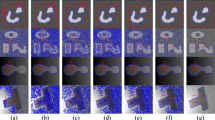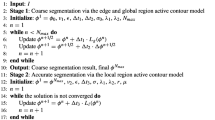Abstract
Original active contour formulations may become ill-posed especially for boundaries characterized by prominent features. Attempts to yield well-posed formulations lead to bias towards short contours. We provide a framework to unify existing bias correcting energy methods and propose a novel local bias correcting scheme similar to non-maximum suppression. Our method can be seen as an approximation to a well-known algorithm that transforms a graph with positive and negative weights to a graph with only positive weights while preserving the shortest paths among the nodes.
Access this chapter
Tax calculation will be finalised at checkout
Purchases are for personal use only
Preview
Unable to display preview. Download preview PDF.
Similar content being viewed by others
References
Kass, M., Witkin, A., Terzopoulos, D.: Snakes: Active Contour Models. In: Int’l Conference on Computer Vision. IEEE, Los Alamitos (1987)
Mortensen, E., Barrett, W.: Intelligent Scissors for Image Composition. In: SIGGRAPH (1995)
Mortensen, E., Barrett, W.: Interactive Segmentation with Intelligent Scissors. Graphical Models and Image Processing 60 (1998)
Falcao, A., Udupa, J., Samarasekera, S., Sharma, S.: User-Steered Image Segmentation Paradigms: Live Wire and Live Lane. Graphical Models and Image Processing 60, 233–260 (1998)
Jermyn, I., Ishikawa, H.: Globally optimal regions and boundaries as minimum ratio weight cycles. IEEE Transactions on Pattern Analysis and Machine Intelligence 23, 1075–1088 (2001)
Mortensen, E., Barrett, W.: A Confidence Measure for Boundary Detection and Object Selection. In: Proc. Computer Vision and Pattern Recognition. IEEE, Los Alamitos (2001)
Mortensen, E., Jia, J.: A Bayesian Network Framework for RealTime Object Selection. In: Proc. Workshop on Perceptual Organization on Computer Vision. IEEE, Los Alamitos (2004)
Pavlopoulou, C., Yu, S.X.: Boundaries as Contours with Optimal Appearance and Area of Support. In: 7th Int’l Conf. on Energy Minimization Methods in Computer Vision and Pattern Recognition (2009)
Geiger, D., Gupta, A., Costa, L., Vlotzos, J.: Dynamic Programming for Detecting, Tracking, and Matching Deformable Contours. IEEE Transactions on Pattern Analysis and Machine Intelligence 17, 294–302 (1995)
Malladi, R., Sethian, J.A., Vemuri, B.C.: Shape Modeling with Front Propagation: A Level Set Approach. IEEE Transactions on Pattern Analysis and Machine Intelligence 17, 158–175 (1995)
Neuenschwander, W., Fua, P., Iverson, L., Szekely, G., Kubler, O.: Ziplock Snakes. Int’l Journal of Computer Vision 25, 191–201 (1997)
Cohen, L.: On Active Contour Models and Balloons. Computer Vision Graphics and Image Processing: Image Understanding 52, 211–218 (1991)
Paragios, N., Deriche, R.: Geodesic Active Contours and Level Set Methods for Supervised Texture Segmentation. International Journal on Computer Vision 46, 223–247 (2002)
Gérard, O., Deschamps, T., Greff, M., Cohen, L.D.: Real-time Interactive Path Extraction with on-the-fly Adaptation of the External Forces. In: European Conference in Computer Vision (2002)
Sullivan, J., Blake, A., Isard, M., MacCormick, J.: Bayesian Object Localisation in Images. Int. J. Comput. Vision 44, 111–135 (2001)
Allili, M., Ziou, D.: Active contours for video object tracking using region, boundary and shape information. Signal, Image and Video Processing 1, 101–117 (2007)
Joshi, S.H., Srivastava, A.: Intrinsic bayesian active contours for extraction of object boundaries in images. Int. J. Comput. Vision 81, 331–355 (2009)
Schoenemann, T., Cremers, D.: Globally optimal image segmentation with an elastic shape prior. In: IEEE International Conference on Computer Vision, ICCV (2007)
Rother, C., Kolmogorov, V., Blake, A.: Grab-cut Interactive Foreground Extraction Using Iterated Graph Cuts. ACM Trans. Graph (SIGGRAPH) 23, 309–314 (2004)
Cormen, T., Leiserson, C., Rivest, R.: Introduction to Algorithms. McGraw-Hill, New York (1990)
Author information
Authors and Affiliations
Editor information
Editors and Affiliations
Rights and permissions
Copyright information
© 2009 Springer-Verlag Berlin Heidelberg
About this paper
Cite this paper
Pavlopoulou, C., Yu, S.X. (2009). A Unifying View of Contour Length Bias Correction. In: Bebis, G., et al. Advances in Visual Computing. ISVC 2009. Lecture Notes in Computer Science, vol 5875. Springer, Berlin, Heidelberg. https://doi.org/10.1007/978-3-642-10331-5_84
Download citation
DOI: https://doi.org/10.1007/978-3-642-10331-5_84
Publisher Name: Springer, Berlin, Heidelberg
Print ISBN: 978-3-642-10330-8
Online ISBN: 978-3-642-10331-5
eBook Packages: Computer ScienceComputer Science (R0)




